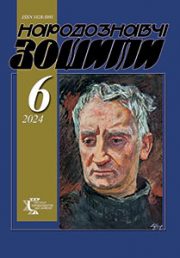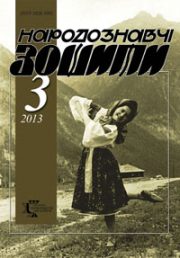The Ethnology Notebooks. 2019, № 6 (150), 1551—1556
UDK75.052 (477)”191/193″
DOI https://doi.org/10.15407/nz2019.06.1551
BOYCHUKISMAS SPECIFIC MANIFESTATION OF THE UKRAINIAN AVANT-GARDE PHENOMENON
PUZYRKOVA Anna
ORCID ID: https://orcid.org/0000-0001-8183-7731
Master of Painting, аpplicant of the Department
of Theory and History of Art NAOMA.
MVDUK. Head of the Department for the Study
of Life and Work of M. Staritsky,
Str. Saksaganskogo, 97. Kyiv, 01032
e-mail: annaprk82@gmail.com
Abstract. Introduction. In art studies that devoted to the period of Ukrainian avant-garde art of 1900—1930s, a significant place is given to the phenomenon of Boychukism, which was accompanied by development of the most radical artistic manifestations of time: Cubo-Futurism, Suprematism and Constructionism. The scientific works of Y. Kravchenko, S. Bilokinia, O. Ripko, L. Sokoliuk and other sare devoted to creative activities of Mykhailo Boychuk and students of his school.
Problem Statement. At the same time, all issues and questions that are still controversial or, conversely, are neglected, include the question of position of the Boychukists’ movement in the context of the avant-garde phenomena of art of 1900—1930s, and the definition of the search of Boychukists such as B. Sedliar, I. Padalka, O. Pavlenko, S. Nalepynska and others as avant-garde.
Purpose. In order to study the creative activities of Boychukists in the publication, the following task was set: using the comparative approach to analyze and compare main manifestations of the art of Boychukists with the artistic movements of classical avant-garde, to analyze the definitions of Boychukism in scientific worksof leading researchers of the Ukrainian artistic avant-garde such as D. Gorbachov, O. Fedoruk, M. Mudrak and others.
Methods. The study relies on the methods of comparative analysis and formal and stylistic analysis.
Results. The results of the study focused on the common features and differences between the creative activitiesof the followers of Mykhailo Boychukin the context of manifestations of European Modernism and avant-garde, emphasizing the feature of Boychukism as specific manifestation of the Ukrainian avant-garde that distinguished it, both in relation to the European and Russian artistic avant-garde, and the possibility to consider some manifestations of Boychukismin the context of avant-garde art was defined.
At the same time, taking into account the fundamental differences between the basics of Boychukism and the classical avant-garde of 1900—1930s, foremost the definition of Boychukism corresponds to the search for Modernism, which included both radical avant-garde and impressionistic, expressionistic and primitive type of artistic explorations.
Conclusion. Different directions of activities of the representatives of Boychukism, their interaction with artistic movements of the avant-garde of 1900—1930s and creative activities of individual artists require further research and thorough analysis.
Keywords: Ukrainian avant-garde of the 1900—1930s, school of Mykhailo Boychuk, Boychukism, Byzantinism, Neo-byzantinism, Neo-primitivism, Expressionism, Modernism.
Received 12.11.2019
REFERENCES
Kravchenko, Y. O. (2010). Mykhailo Boychuk’s School. Thirty Seven Names. Kyiv: Maysternya knigi; Oranta [in Ukraine].
Vlasov, V.G., & Lukina, N.Y. (2005). Avant-gardism. Modernism. Postmodernism. Terminological Dictionary. Saint-Petersburg, Russia: ABC-Classics [in Russian].
Rychkova, Y.V. (2002). Encyclopedia of Modernism. Moscowa: EKSMOPress [in Russian].
Richard, R. Brettell. (1999). Modern Art 1851—1929. Capitalism and representation. Oxford university press.
Kovalchuk, O.V. (2005). Artist, Pedagogue-Innovator (Tо the 120th nniversary of M.L. Boychuk’s Birthday). Ukrainian Academy of Arts: Collection of Works on Researchand Methods. Journal, 13, 250—263. Kyiv: NAOMA [in Ukraine].
Sokolyuk, L.D. (2014). Mykhailo Boichuk and his School. Issued by Savchuk [in Ukraine].
Sokolyuk, L.D. (2003). Features of Expressionism in Works of Representatives of Mykhailo Boichuk’s School. In Russian Avant-Garde between 1910s and 1920s and Problem of Expressionism. Journal (Pp. 326—339). Moscow: Science [in Russian].
Lahutenko, О.А. (2006). Ukrainian graphics of the 1 t third of 20th Century. Kyiv: Hrani-T [in Ukraine].
Aseeva, N.Y. (2000). Ukrainian Avant-Garde Artists’ Speechesin France, 1910—1920’s. Russian Avant-Garde of 1910—1920’s in European Context. Journal (Pp. 133—143). Moscow: Science [in Russian].
Sokolyuk, L.D. (1993). Boichukism and a Problem of Style in Ukrainian Art of the 1st half of 20th Century. Reprint. Kyiv [in Ukraine].
Ripko, O.O. (1991). Boichuk and Boichukists, Boichukism. Exhibition Catalogue. Lviv [in Ukraine].
Mykhailo Boychuk. Byzantism. Ukrainian Avant-Gardistsas The orists and Publicists (Pp. 97—98). Kyiv: Triumph [in Ukraine].
Gorbachov, D.О. (1996). Ukrainian Avant-Garde of 1910—1930’s. Кiev: Mustetstvo [in Ukraine].
Birnie Danzker, J.A. (1993). Die Avantgarde und die Ukraine. Avantgard & Ukraine (Pp. 13—41). Munchen: Klinghard & Biermann,
Mudrak, M. (2018). «New Generation» and Artistic Modernism in Ukraine. Kyiv: RODOVID [in Ukraine].
Fedoruk, O. (2006). Ukrainian Avant-Garde. Sign Crossing: in 3 Books. Book 1: History and Theory of Art. Figures. Folk Art (Pp. 9—68). Kyiv: Vyd. dim A+С [in Ukraine].
Maydanets-Bargylevych, O. (2005). Mykhailo Boychuk — founder of the National School of Monumental Arts. Ukrainian Academy of Arts: Collection of Workson Researchand Methods. Journal (Vol, 12, pp. 313—324). Kyiv: NAOMA [in Ukraine].
Bura Matsapura, V. (2005). Memories of my teachers M. Boychuk and S. Nalepinsku-Boychuk. Ukrainian Academy of Arts: Collection of Workson Research and Methods. Journal. Kyiv: NAOMA, 13, 52—57 [in Ukraine].
Susak, V. (2005). Paris Period of Mykhailo Boichuk. Bulletin of Kharkiv State Academy of Design and Fine Arts (Vol, 9, pp. 96—110) [in Ukraine].






